人教版高一英语必修二 unit2 Amber Room教学设计
人教版高中英语教案:The+Amber+Room+阅读写作课.doc

精美句子1、善思则能“从无字句处读书”。
读沙漠,读出了它坦荡豪放的胸怀;读太阳,读出了它普照万物的无私;读春雨,读出了它润物无声的柔情。
读大海,读出了它气势磅礴的豪情。
读石灰,读出了它粉身碎骨不变色的清白。
2、幸福幸福是“临行密密缝,意恐迟迟归”的牵挂;幸福是“春种一粒粟,秋收千颗子”的收获. 幸福是“采菊东篱下,悠然见南山”的闲适;幸福是“奇闻共欣赏,疑义相与析”的愉悦。
幸福是“随风潜入夜,润物细无声”的奉献;幸福是“夜来风雨声,花落知多少”的恬淡。
幸福是“零落成泥碾作尘,只有香如故”的圣洁。
幸福是“壮志饥餐胡虏肉,笑谈渴饮匈奴血”的豪壮。
幸福是“先天下之忧而忧,后天下之乐而乐”的胸怀。
幸福是“人生自古谁无死,留取丹心照汗青”的气节。
3、大自然的语言丰富多彩:从秋叶的飘零中,我们读出了季节的变换;从归雁的行列中,我读出了集体的力量;从冰雪的消融中,我们读出了春天的脚步;从穿石的滴水中,我们读出了坚持的可贵;从蜂蜜的浓香中,我们读出了勤劳的甜美。
4、成功与失败种子,如果害怕埋没,那它永远不能发芽。
鲜花,如果害怕凋谢,那它永远不能开放。
矿石,如果害怕焚烧(熔炉),那它永远不能成钢(炼成金子)。
蜡烛,如果害怕熄灭(燃烧),那它永远不能发光。
航船,如果害怕风浪,那它永远不能到达彼岸。
5、墙角的花,当你孤芳自赏时,天地便小了。
井底的蛙,当你自我欢唱时,视野便窄了。
笼中的鸟,当你安于供养时,自由便没了。
山中的石!当你背靠群峰时,意志就坚了。
水中的萍!当你随波逐流后,根基就没了。
空中的鸟!当你展翅蓝天中,宇宙就大了。
空中的雁!当你离开队伍时,危险就大了。
地下的煤!你燃烧自己后,贡献就大了6、朋友是什么?朋友是快乐日子里的一把吉它,尽情地为你弹奏生活的愉悦;朋友是忧伤日子里的一股春风,轻轻地为你拂去心中的愁云。
朋友是成功道路上的一位良师,热情的将你引向阳光的地带;朋友是失败苦闷中的一盏明灯,默默地为你驱赶心灵的阴霾。
高一英语必修2第一单元阅读课教学设计及反思

高一英语必修2第一单元阅读课教学设计及反思高一英语必修2第一单元阅读课教学设计及反思Reading In search of the Amber Room一、教学目标(1)学问目标:让同学了解琥珀屋的历史,熟识本课的重点词组和句型。
(2)力量目标:提高同学的阅读力量,即形成快速猎取信息和处理信息的能力。
(3)情感态度目标:通过自主学习和合作学习,培育同学喜爱文化遗产﹑爱护文化遗产,敬重人民才智的意识。
二、教学设计(1)教学思路整个教学过程以“ 以同学学习主体,老师教为辅”的设计理念,采纳设置任务和小组争论的形式组织教学,将同学的自主学习活动作为课堂的主体,引导同学完成学习任务。
(2)课前预备:要求同学利用阅览室和网络收集有关琥珀屋以及世界闻名文化遗产的信息资料,并预习课文In search of the Amber Room。
完成课后练习一和练习二,以便更好地解读课文。
三、Teaching proceduresStep I Lead-in (two minutes)Show the four pictures about 1.埃及金字塔.,图2 . 中国万里长城图3.紫禁城图4.英国史前巨柱say their English names.[设计说明]使用多媒体播放图片,形象、直观、生动,能吸引同学的留意力,激发同学的爱好。
同时,对同学的课前预习有所了解。
StepⅡ Skim the reading passage and then answer.(six minutes) Skimming the text quickly, then answer questions:①、Why is it called the Amber Room?②、Check Exercise One and Exercise Two on Page2 of the Students’ Book .Exercise One1.Frederick A. stole the Amber Room.2.Frederick William B.Ⅱsent a troop of his best soldiers to the king of Prussia.3.Peter the Great C. had the Amber Room made4.Catherine Ⅱ D. had it moved outside St Petersburg.5.The Nazi army E. gave it to the Czar as a gift.6.The Russians and Germans F. built a new Amber Room Exercise TwoHow did the Amber Room become one of the wonders of the world? How was a new Amber Room built?How did the Amber Room get lost?How was the Amber Room made?Why did the king of Prussia give the Amber Room to the Czar of Russia as a gift?[设计说明]通过课后练习一,对本文消失的人物及相关历史大事的配对练习,以及课后练习二,对段落和各段落大意的配对练习,检查同学对全文内容的理解状况,培育同学学会快速捕获文章表层信息的力量,从而进一步理解文章的中心内容,为下一道推断正误题打好基础。
版本:人教版高中英语必修阅读课InSearchofTheAmberRoom教学设计
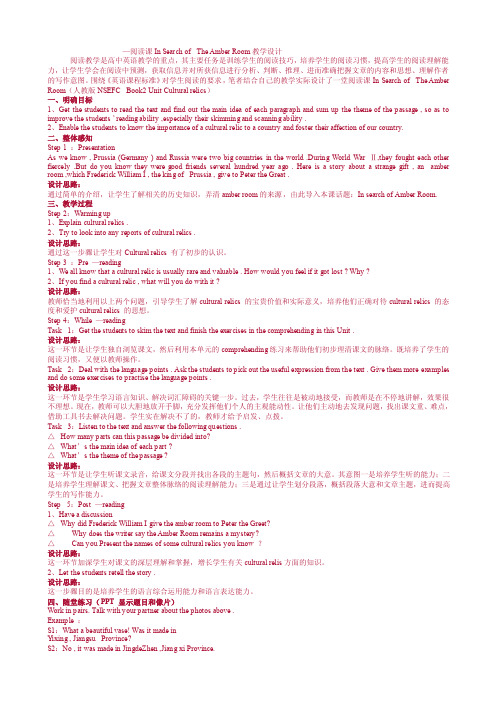
—阅读课In Search of The Amber Room教学设计阅读教学是高中英语教学的重点,其主要任务是训练学生的阅读技巧,培养学生的阅读习惯,提高学生的阅读理解能力,让学生学会在阅读中预测,获取信息并对所获信息进行分析、判断、推理、进而准确把握文章的内容和思想、理解作者的写作意图。
围绕《英语课程标准》对学生阅读的要求,笔者结合自己的教学实际设计了一堂阅读课In Search of The Amber Room(人教版NSEFC Book2 Unit Cultural relics)一、明确目标1、Get the students to read the text and find out the main idea of each paragraph and sum up the theme of the passage , so as to improve the students ’ reading ability ,especially their skimming and scanning ability .2、Enable the students to know the importance of a cultural relic to a country and foster their affection of our country.二、整体感知Step 1 :PresentationAs we know , Prussia (Germany ) and Russia were two big countries in the world .During World War Ⅱ,they fought each other fiercely .But do you know they were good friends several hundred year ago . Here is a story about a strange gift , an amber room ,which Frederick William I , the king of Prussia , give to Peter the Great .设计思路:通过简单的介绍,让学生了解相关的历史知识,弄清amber room的来源,由此导入本课话题:In search of Amber Room. 三、教学过程Step 2:Warming up1、Explain cultural relics .2、Try to look into any reports of cultural relics .设计思路:通过这一步骤让学生对Cultural relics 有了初步的认识。
高一In Search of the Amber Room设计方案

知识点学习目标媒体类型媒体内容要点教学作用使用方式所得结论占用时间媒体来源教学媒体选择分析表通过展示一些图片,让学生讨论图片的共性,继而引出文化遗产的概念。
导入新课In Search ofthe AmberRoom课件展示课件展示文化遗产的图片。
导入新课,让学生对文化遗产有初步认识。
演示—提问—讨论—总结学生对文化遗产有了初步认识,为课文作了铺垫。
3分钟自制课件通过琥珀图片的展示和标题让学生预测文章大意。
学生学习预测文章大意课件展示课件展示琥珀图片引发学生兴趣,培养学生预测大意的能力。
演示—学生思考感叹琥珀的美,惊讶于用琥珀打造的宫殿,心中有各自的预测。
2分钟自制课件通过略读读掌握课文大意略读训练课件展示课件展示教师的提示信息培养学生快速获取文章大意的能力演示—提问了解文章大意2分钟自制课件通过寻读找出文章基本信息寻读训练课件展示课件展示所要找出的信息培养学生快速浏览的能力演示—提问学生找出人物时间及事件4分钟自制课件通过分段精读让学生能进一步的了解课文内容,并根据基本信息完善文章线索。
精读训练课件展示课件展示文中人物时间及事件精读掌握课文细节,理清文章脉络。
演示—提问—讲解了解琥珀屋的历史,理清文章脉络。
20分钟自制课件在学习完课文的基础上通过角色扮演和上台展示强化对文章的理解。
两两角色扮演并上台展示课件展示课件展示分组和其扮演的角色培养学生总结归纳能力并进行口语锻炼。
演示—角色扮演—上台展示学生对文章进行了归纳并得到了口语锻炼。
12分钟自制课件课件展示本课课后作业内容布置作业课件展示本课课后作业内容复习,巩固演示复习巩固。
2分钟自制课件附:教学设计方案教学设计方案案例名称In Search of the Amber Room科目高中英语教学对象高一学生提供者课时1课时一、教材内容分析The teaching material is the reading part from Unit1,Module2 NSEFC. The topic of this unit is cultural relics and the protection of the culture relics.The reading passage tells the strange history of the Amber Room, a cultural relic of two countries: Germany and Russia.It is a relic which has been lost, and the Amber Room that people can see today is actually a reproduction.二、教学目标(知识,技能,情感态度、价值观)1. Knowledge aimsSs can master the key words and phrases of the passage as follows, amazing, fancy, style, less than, in return, reception, remove, wooden, doubt, former, at war.Ss can learn the history of the amber room, especially the design, the loss and the rebuilding of the amber room.2. Ability aimsSs can predict the content of the passage based on the title.Ss can scan the passage and find out the specific information such as the person related with the amber room.Ss can summarize the passage with the help of the clues of the passage.3. Emotion aimsSs will realize that the cultural relics are rare and precious and they will concern themselves with the issue of cultural relic’s protection.4. Cultural awarenessSs will broaden their minds by knowing something about amber room.三、学习者特征分析The following are the characteristics of the learners:·The students are from Grade1 in senior high school.·The students have achieved certain English level and they have the ability to get the basic message of the reading.·The students are easily activated and want to air their own opinions on the topic·The students know some cultural relics at home and abroad.·They may not know the amber room before.·Their vocabulary is limited so they may have difficulties in understanding some sentences.四、教学策略选择与设计1.Ask and answer approach:teacher guide by asking questions2.Task-based approach :students are expected to achieve certain goal by finishing the task3.The situational approach:students are activated to devote themselves into role-play五、教学环境及资源准备PPTMultimedia room六、教学过程教学过程教师活动学生活动设计意图及资源准备Stage1Lead-inand warming-up Show somepictures andorganize thediscussion1.Look at the screen and tell thename of the cultural relics.2.Discuss what these pictureshave in common and try to sumup the definition of culturalrelicsTo arouse the Ss’interests in the topicand activate their oldknowledge of cult uralrelicsStage2 Pre-reading T shows somepictures ofamber and asksstudents topredict1.Look at these pictures and getthe perceptual knowledge of theamber2.Look at the title quickly anddo some predictions:1)What is it mainly about?2)What happened to the it?To activate studentsand make them eagerto know a room madeof amber.To help Ss developthe reading skills ofpredicting.Stage3 While reading Step1SkimmingT shows aquestion on thescreen.Read the text quickly and try tofill the main idea.It tells us the strange history ofthe_______ ________, acultural relic of two countries:_________ and_________.To train the studentsto find the main ideaquicklyStep2ScanningT shows 3 words on the blackboard:time place andcharcters Students are organized to findthe certain message accordingto the 3 wordsTo train students toget certaininformation quicklyStep3 CarefulreadingT shows some pictures and guide students. Students are also expected tounderstand the passage and findout the clue with the help of theteacher.To develop theirreading strategies andlanguage efficiency.Stage 4 Post readingT creates asituationandorganizes therole-play byshowing thekey words onthe screen.Students do pair work. One ofthem is the visitor and the otherone is the guide. The guide willintroduce the AmberRoom,while the visitor will asksome questions about theAmber RoomThe role play servesas an output of thereading and anevaluation of theirlearning.Stage5 Homework T assigns thehomeworkSs write a summary of the history ofthe Amber Room and hand it in thenext day.Ss review the words and phrase ofthe passage and make sentence witheach.To consolidate theknowledge learned inclass.教 学 过 程 流 程 图七、教学评价设计Students are expected to do self-assesment according to the knowledge they learned in thelesson,and their attitudes towards the task in the lesson.八、帮助和总结Students are active in the role-play,which enable them to put what they learned into use.While- readingPost- readingHomeworkskimmingscanning careful readingretellingreviewWarming- up Pre-reading。
人教新课标版必修2Unit 1 InSearch Of The Amber Room阅读课教学设计

P r2P r. 一 P a -h aighs r o ea br a (aa t —— 一 a . ) ea z io fh m e r —-t m n ty t
r oom .
1由 于是 一篇 阅 读 课 . 计 的基 本 原 则 之 一 就 是 要 训 练 学 . 设
生 的 各 种 常 见 阅 读 技 巧 . 如 迅 速 浏 览 . 括 图 片 和 题 目 以及 比 包
1T e a e o m a i d t e t e g e ts i o t e . h mb r ro w s ame o b h r ae tgf t h t
Ca. zr 2T e b s rit s e t ma y y a s n t e d sg f t e . e t t ss p n n e r o h e in o h h a m e m. a b rr o o
( )F d r k a tma e a d te a e o m ev d e i r e c 1 h d i d n I mb rro sre l
a e e t n h l f r mp r n ii r . sa r c p i a l o ot tvst s o i a o
p it e r ti h a s g . on swe la n t e p s a e n
曩
( 计 说 明 : 琥 珀 图 片 导 人 本 节 阅 读 内容 , 设 用 提示 学 生 注 意
点 在 I erhO 和 R o 上 ) nSac f om
S e h e Re d n n kmmi g tp T r e a ig a d S i n
fo t e a e o r m mb rr m. h o
人教版Unit2《Room》教案
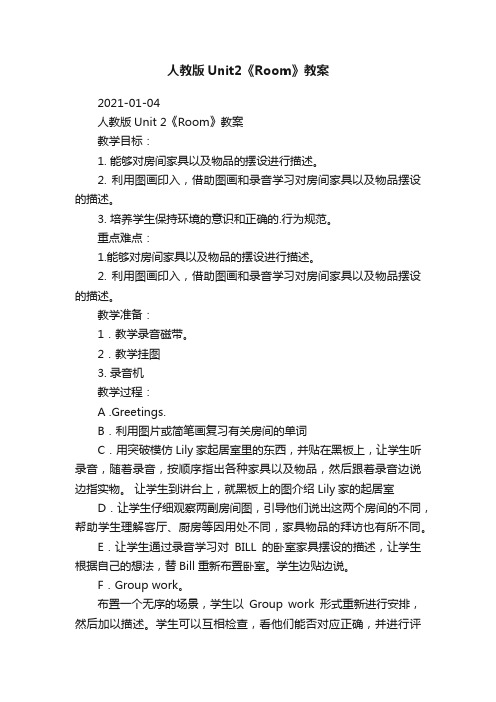
人教版Unit2《Room》教案2021-01-04人教版Unit 2《Room》教案教学目标:1. 能够对房间家具以及物品的摆设进行描述。
2. 利用图画印入,借助图画和录音学习对房间家具以及物品摆设的描述。
3. 培养学生保持环境的意识和正确的.行为规范。
重点难点:1.能够对房间家具以及物品的摆设进行描述。
2. 利用图画印入,借助图画和录音学习对房间家具以及物品摆设的描述。
教学准备:1.教学录音磁带。
2.教学挂图3. 录音机教学过程:A .Greetings.B.利用图片或简笔画复习有关房间的单词C.用突破模仿Lily家起居室里的东西,并贴在黑板上,让学生听录音,随着录音,按顺序指出各种家具以及物品,然后跟着录音边说边指实物。
让学生到讲台上,就黑板上的图介绍Lily家的起居室D.让学生仔细观察两副房间图,引导他们说出这两个房间的不同,帮助学生理解客厅、厨房等因用处不同,家具物品的拜访也有所不同。
E.让学生通过录音学习对BILL的卧室家具摆设的描述,让学生根据自己的想法,替Bill重新布置卧室。
学生边贴边说。
F.Group work。
布置一个无序的场景,学生以Group work形式重新进行安排,然后加以描述。
学生可以互相检查,看他们能否对应正确,并进行评价。
人教版Unit 2《Room》教案教学目标:1. 能够对房间家具以及物品的摆设进行描述。
2. 利用图画印入,借助图画和录音学习对房间家具以及物品摆设的描述。
3. 培养学生保持环境的意识和正确的.行为规范。
重点难点:1.能够对房间家具以及物品的摆设进行描述。
2. 利用图画印入,借助图画和录音学习对房间家具以及物品摆设的描述。
教学准备:1.教学录音磁带。
2.教学挂图3. 录音机教学过程:A .Greetings.B.利用图片或简笔画复习有关房间的单词C.用突破模仿Lily家起居室里的东西,并贴在黑板上,让学生听录音,随着录音,按顺序指出各种家具以及物品,然后跟着录音边说边指实物。
人教版高一英语必修2琥珀屋说课稿
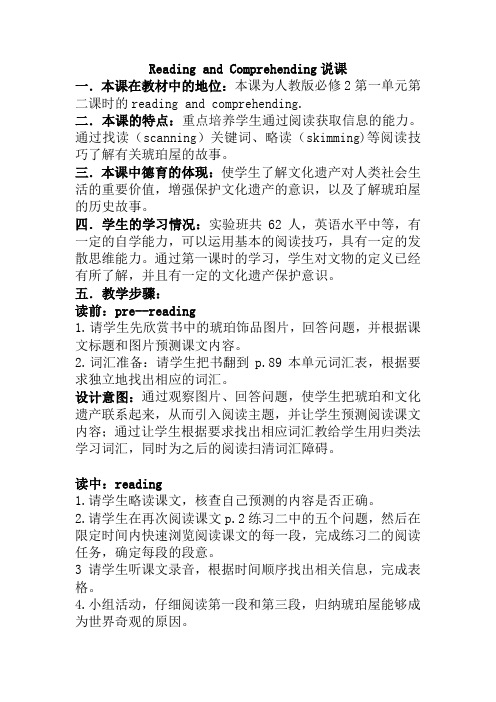
Reading and Comprehending说课一.本课在教材中的地位:本课为人教版必修2第一单元第二课时的reading and comprehending.二.本课的特点:重点培养学生通过阅读获取信息的能力。
通过找读(scanning)关键词、略读(skimming)等阅读技巧了解有关琥珀屋的故事。
三.本课中德育的体现:使学生了解文化遗产对人类社会生活的重要价值,增强保护文化遗产的意识,以及了解琥珀屋的历史故事。
四.学生的学习情况:实验班共62人,英语水平中等,有一定的自学能力,可以运用基本的阅读技巧,具有一定的发散思维能力。
通过第一课时的学习,学生对文物的定义已经有所了解,并且有一定的文化遗产保护意识。
五.教学步骤:读前:pre--reading1. 请学生先欣赏书中的琥珀饰品图片,回答问题,并根据课文标题和图片预测课文内容。
2. 词汇准备:请学生把书翻到p.89本单元词汇表,根据要求独立地找出相应的词汇。
设计意图:通过观察图片、回答问题,使学生把琥珀和文化遗产联系起来,从而引入阅读主题,并让学生预测阅读课文内容;通过让学生根据要求找出相应词汇教给学生用归类法学习词汇,同时为之后的阅读扫清词汇障碍。
读中:reading1.请学生略读课文,核查自己预测的内容是否正确。
2.请学生在再次阅读课文p.2练习二中的五个问题,然后在限定时间内快速浏览阅读课文的每一段,完成练习二的阅读任务,确定每段的段意。
3 请学生听课文录音,根据时间顺序找出相关信息,完成表格。
4.小组活动,仔细阅读第一段和第三段,归纳琥珀屋能够成为世界奇观的原因。
设计意图:通过略读课文检测读前预测是否正确,并对课文内容有大体的了解;练习二的五个问题分别概括了每段的段意,考虑到高一学生概括能力较弱,采取给出各段段意让他们分别找出与其匹配的段落的方式降低了难度;通过回答五个问题使学生了解课文的细节内容,明确概括段意的依据;通过填表让学生学会根据时间、人物等关键词快速确定主要信息;通过仔细阅读和分析课文重点内容培养学生的分析能力,同时也使他们进一步理解琥珀屋作为文化遗产的理由。
人教新课标高一英语必修二第2单元教案
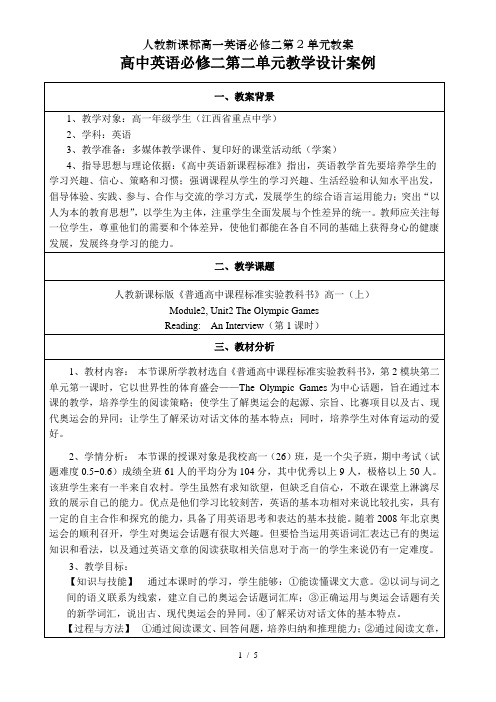
1、以任务型教学为理念,强调教学方法的灵活性和多样性。
2、采用 5P 教学法(即 preparation, presentation, practice, production, progress),学生通过 自学、讨论、交流、询问、演练等各种形式来学习并掌握语言,从而使语言的学习富有成 效。
教学活动 Activities
(Preparation) Warming up and Pre-reading
2/5
Байду номын сангаас
设计意图 Intentions
互动模式 &时间
IP & time
人教新课标1. A quiz: Ss discuss to answer the
曲导入。
3'
Step 1
questions about the Olympic Games. 引导学生通过回答问卷,激活学
生已有的背景知识,使学生积极
主动地参与本单元中心话题的
GW
2. Check the answers.
思考与讨论。
1'
1. Ss descib教学课题
人教新课标版《普通高中课程标准实验教科书》高一(上) Module2, Unit2 The Olympic Games Reading: An Interview(第 1 课时)
三、教材分析
1、教材内容: 本节课所学教材选自《普通高中课程标准实验教科书》,第 2 模块第二 单元第一课时,它以世界性的体育盛会——The Olympic Games 为中心话题,旨在通过本 课的教学,培养学生的阅读策略;使学生了解奥运会的起源、宗旨、比赛项目以及古、现 代奥运会的异同;让学生了解采访对话文体的基本特点;同时,培养学生对体育运动的爱 好。
人教版高中英语面试真题-《The Amber Room》试讲及教案、教学设计

《The Amber Room》试讲及教案、教学设计1. Teaching aims1) Knowledge aimStudents will be able to know some basic knowledge about argumentative writing.2) Ability aimStudents can improve their writing skill.3) Emotional aim1. Students can enjoy expressing their opinion in written and oral form freely.2. Students can know the importance of protecting cultural relics2. Important and difficult points1) Important pointStudents can master some basic knowledge about argumentative writing.2) Difficult pointStudents can develop their logical thinking ability through writing.3. Teaching and learning methodsCommunicative teaching method; task-based teaching method;group work method; cooperation study method; independent study method4. Teaching proceduresStep 1: Lead inReviewRetell In Search of the Amber Room to recall the end of the Amber RoomStep 2: Pre-writingAnalyze the letter to conclude Weber’s attitude towards the Amber Room.- So I think that those who find the Amber Room should decide what to do with it.Step 3: While-writingActivity1: Debate.By debating, students can have the outline of their letter.Activity2: Students can write the letter after teacher’s leading.Activity3: After writing, teacher ask students to have peer-editing.Step4: Post-writingShow timeTeacher select at least one student to show his/her writing and ask other students to takes notes of good words, phrases and sentences.Step 6: Summary and homeworkSummary: The teacher ask students to show the summary.Homework: Students polish their writing and hand in.5. Blackboard design。
高中英语_In search of the amber room教学设计学情分析教材分析课后反思
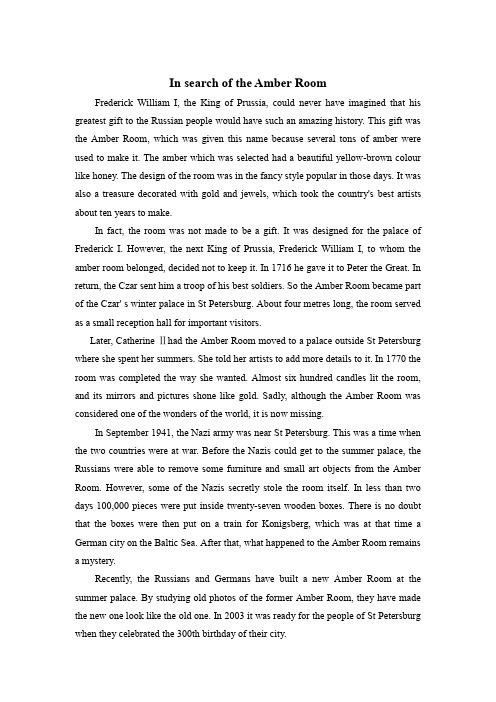
In search of the Amber RoomFrederick William I, the King of Prussia, could never have imagined that his greatest gift to the Russian people would have such an amazing history. This gift was the Amber Room, which was given this name because several tons of amber were used to make it. The amber which was selected had a beautiful yellow-brown colour like honey. The design of the room was in the fancy style popular in those days. It was also a treasure decorated with gold and jewels, which took the country's best artists about ten years to make.In fact, the room was not made to be a gift. It was designed for the palace of Frederick I. However, the next King of Prussia, Frederick William I, to whom the amber room belonged, decided not to keep it. In 1716 he gave it to Peter the Great. In return, the Czar sent him a troop of his best soldiers. So the Amber Room became part of the Czar' s winter palace in St Petersburg. About four metres long, the room served as a small reception hall for important visitors.Later, Catherine Ⅱhad the Amber Room moved to a palace outside St Petersburg where she spent her summers. She told her artists to add more details to it. In 1770 the room was completed the way she wanted. Almost six hundred candles lit the room, and its mirrors and pictures shone like gold. Sadly, although the Amber Room was considered one of the wonders of the world, it is now missing.In September 1941, the Nazi army was near St Petersburg. This was a time when the two countries were at war. Before the Nazis could get to the summer palace, the Russians were able to remove some furniture and small art objects from the Amber Room. However, some of the Nazis secretly stole the room itself. In less than two days 100,000 pieces were put inside twenty-seven wooden boxes. There is no doubt that the boxes were then put on a train for Konigsberg, which was at that time a German city on the Baltic Sea. After that, what happened to the Amber Room remains a mystery.Recently, the Russians and Germans have built a new Amber Room at the summer palace. By studying old photos of the former Amber Room, they have made the new one look like the old one. In 2003 it was ready for the people of St Petersburg when they celebrated the 300th birthday of their city.Teaching contents: Book 2 Unit 1 In search of the Amber RoomType of the class: ReadingTeaching Targets:1. Knowledge Targets: to use the important words and expressions of the text and to know about the history of the Amber Room2. Ability Targets: to have a general knowledge of the history of Amber Room and can retell the story briefly: to give their opinions on protecting and rebuilding lost cultural relics; to improve their reading ability, especially their skimming skills and scanning skills,3. Emotional Targets:to be more interested in cultural relics and to have the awareness of protecting cultural relics, to treasure what you have.Teaching important and difficult points:1)Improve the reading skills of the students.2)Enable the students to catch the detailed information of the amber room. Learning methods: individual learning and cooperative learning.Teaching procedures:Task 1 Read for main ideaThe following five questions summarize the main idea of the five paragraphs in the passage. Put the paragraph numbers before each question.1.How did the Amber Room become one of the wonders of the world?2.How was a new Amber Room built?3. How did the Amber Room get lost?4. How was the Amber Room made?5. Why did the King of Prussia give the Amber Room to the Czar of Russia as a gift? Task 2 Read for detailWhat did the following people from the text do?1.Frederick I2.Frederick William I3.Peter the Great4.Catherine II5.The Nazi army6.The Russians and GermansTask 3 Read for summary writing(概要写作)Write a summary of the story about the amber room in not more than 50 words. Task 4 Read for discussionThe amber room is a long-lost priceless treasure, which is nowhere to be found now. Similarly, in our lives, we also lost many valuable things that we call "treasures", such as loved ones, pets, toys....Now, if you are allowed to search for only one of the "t reasures",and it's quite probable to get it back. Which treasure would you like to search for and recover? Why?We all have a great number of treasures all through our lives.Sometimes we never think of valuing our treasure until it becomes a memory, and only then do we begin to search for it and try to get it back.So, please treasure your treasure while you have the treasure. (treasure vt. 珍惜, 珍视; n宝藏, 珍宝。
人教版必修第二册Unit2_单元活动设计

Unit2 单元活动设计参考案例一活动方式:Pair Work (SB, P15,Part 5)活动内容:Discuss and role-play.Discuss the questions below in pairs:1.What do you know about the animals in the photos?2.What is being done to help them?Then role-play the conversation and talk about one of the animals in the photos below.学情分析:通过阅读已经获取到的有关野生动物的现状及保护措施等信息,以及在生活中观察到的一些动物的处境,在开展这个活动时,学生有较丰富的背景知识和生活经验,应该有话可说。
教学目标:学生通过讨论,促进所学语言和文化知识的运用、语言表达技能的发展,加深对主题意义的理解,提高学生的批判性思维能力,帮助其形成人与动物和谐相处的正确价值观。
学习活动:1.小组讨论两个问题,激活学生关于野生动物的背景。
2.各小组组长汇总小组成员的认识和观点并展示。
3.小组中两两进行角色扮演,朗读对话内容。
4.教师邀请几个小组展示对话内容。
5.创编对话:小组合作谈论图片中的一种动物并进行练习。
6.小组表演创编对话。
案例二活动方式: Role-play (SB, P19, Part 5)活动内容:Talk about wildlife protection.学情分析:本活动目的是让学生使用恰当的语言讨论自己熟悉的濒危动物及其保护措施。
学生通过课本提供的维持对话的功能句型和对话范例,可以降低对话的难度。
通过这个活动,可以激发学生对野生动物保护的关注,也可以帮助学生表达自己的想法,形成正确的野生动物的保护意识,实现育人的功能。
教学目标:使用恰当的语言讨论野生动物和保护。
学习活动:1.教师呈现街区流浪猫的相关图片,引起学生的兴趣。
人教版_高中英语必修2全套教案_全册教学设计
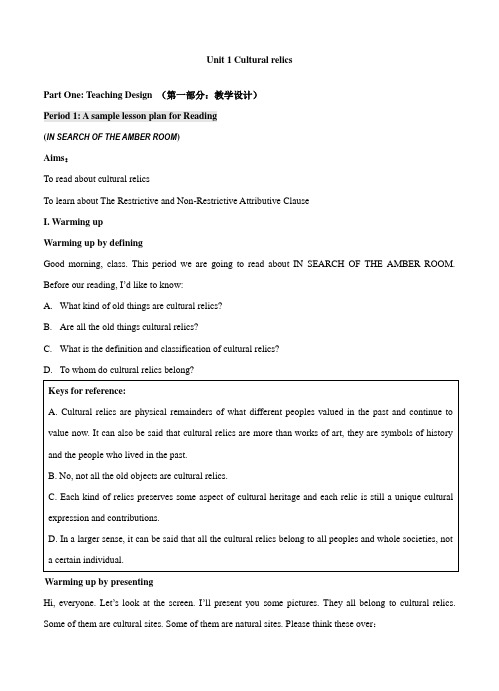
Unit 1 Cultural relicsPart One: Teaching Design (第一部分:教学设计)Period 1: A sample lesson plan for Reading(IN SEARCH OF THE AMBER ROOM)Aims:To read about cultural relicsTo learn about The Restrictive and Non-Restrictive Attributive ClauseI. Warming upWarming up by definingGood morning, class. This period we are going to read about IN SEARCH OF THE AMBER ROOM. Before our reading, I’d like to know:A.What kind of old things are cultural relics?B.Are all the old things cultural relics?C.What is the definition and classification of cultural relics?D.To whom do cultural relics belong?Warming up by presentingHi, everyone. Let’s look at the screen. I’ll present you some pictures. They all belong to cultural relics. Some of them are cultural sites. Some of them are natural sites. Please think these over:A.Can you name them out?B.Who have the right to confirm and classify them?Warming up by discussingNow, boys and girls, I met a “moral dilemma”. That means I must make a choice between the interests of the family and the interests of the society. Things are like this: My old granny happened to find an ancient vase under the tree in the earth of our garden. It’s so beautiful and special. Now, my family fell into a moral dilemma. Can you help us to make a decision:A: What should we do?B: Can we keep it for ourselves or report it to the government?C: Have you come across such a situation —to make a difficult choice?II. Pre-reading1. Looking and sayingWork in pairs. Look at the photos on the screen. All these relics are quite beautiful. But some of them were lost and ruined in history,such as Yuan MingY uan and the Amber Room. Please guess:A.What kinds of things can result in their disappearing?B.Why do they come into being once again?2. Explaining and sharingWork in groups of four. Tell your group mates:A.What do you know about the substance of “amber”?B.What do you know about the cultural relics “the Amber Room”?III. Reading1. Reading aloud to the recordingNow please listen and read aloud to the recording of the text IN SEARCH OF THE AMBER ROOM. Pay attention to the pronunciation of each word and the pauses within each sentence. I will play the tape twice and you shall read aloud twice, too.2. Skimming and identifying the general idea of each paragraphNow please skim the text to get the key words and general idea of each paragraph.3.Scanning and analyzing the characteristics of the text.Since you have got to know the general ideas of each paragraph, can you tell me the characteristics of the passage, such as, the type of writing, the way of narrating, and the tense?4.Reading and understandingNext you are to read and underline all the useful expressions or collocations in the passage. Copy them to your notebook after class as homework.5. Reading and transferring informationRead the text again to complete the table, which lists all the numbers in the text.6.Reading and learningRead the text and learn more about the following proper nouns. You can surf on the website after class:ⅣClosing downClosing down by doing exercisesTo end the lesson you are to do the comprehending exercises No. 1 and No. 2.Closing down by having a discussionA.Can you imagine the fate of the Amber Room? What is it?B.Do you think if it is worthwhile to reproduce the Amber Room? Why?Closing down by retelling the story of the Amber RoomWell, all of us have learned the history of the Amber Room. Let’s recall some key words and expressions on the board. You are to retell the story of the Amber Room:Period 2: A lesson plan for Learning about Language(The Restrictive and Non-Restrictive Attributive Clause)Aims:To learn about the restrictive and non-restrictive attributive clauseTo discover some useful words and expressionsTo discover some useful structuresProcedures:I. Warming upWarming up by discovering useful words and expressionsPlease turn to page 3. Do exercises 1, 2, 3 and 4 first. Please check your answers against your classmates’. Warming up by explainingNow, class, since you’ve read the passage, could you explain to me how to use the phrase “belong to”? The word “to”here is a preposition, indicating the possession, and is always followed by nouns or pronoun.Look at Ex 3. The preposition “at”indicates a state, condition or continuous activity. So we can replace them or express them by using a present-continuous tense.II. Learning about Attributive Clause1. What is an adjective Clause?An adjective clause is a dependent clause which takes the place of an adjective in another clause or phrase. Like an adjective, an adjective clause modifies a noun or pronoun, answering questions like “which?” or “what kind of?” Consider the following examples:Adjectivethe red coatAdjective clausethe coat which I bought yesterdayLike the word “red” in the first example, the dependent clause “which I bought yesterday” in the second example modifies the noun “coat.” Note that an adjective clause usually comes after what it modifies, while an adjective usually comes before.In formal writing, an adjective clause begins with the relative pronouns “who(m),” “that,” or “which.” In informal writing or speech, you may leave out the relative pronoun when it is not the subject of the adjective clause, but you should usually include the relative pronoun in formal, academic writing:informalThe books people read were mainly religious.formalThe books that people read were mainly religious.informalSome firefighters never meet the people they save.formalSome firefighters never meet the people whom they save.Here are some more examples of adjective clauses:the meat which they ate was taintedThis clause modifies the noun “meat” and answers the question “which meat?”.They’re talking about the movie which made him cryThis clause modifies the noun “movie” and answers the question “which movie?”.They are searching for the student who borrowed the bookThe clause modifies the pronoun “student” and answers the question “which student?”.Did I tell you about the author whom I met?The clause modifies the noun “author” and answers the question “which author?”.2. Restrictive & non restrictive clausesDo the following pairs of sentences mean the same thing?1a My uncle, who lives in London, is very rich.2b My uncle who lives in London is very rich.2a The policies, which were unpopular, were rejected by the voters.2b The policies which were unpopular were rejected by the voters.3a My niece, whose husband is out of work, will inherit the house, which I have always treasured.3b My niece whose husband is out of work will inherit the house which I have always treasured.The first sentence in each pair has a non-restrictive clause within two commas, and the second has a restrictive clause. A non-restrictive clause simply adds more information into the sentence and does not affect the meaning of the main clause: it is therefore bracketed off with commas (1a = an uncle who happens to live in London). Conversely, a restrictive clause defines its referent in the main clause more specifically and contributes significantly to the meaning of the sentence. Thus it is that particular uncle who lives in London who is referred to (1b). In 2a, all policies were unpopular and all were rejected, whereas in 2b only the policies that were unpopular were rejected. Note that in restrictive clauses the non-human relative pronoun is either ‘that’ or ‘which’, whereas for human referents the relative pronoun can be either ‘who/m’ or ‘that’ (the man that/whom I will marry ....).3. A test on FORMAL ADJECTIVE CLAUSESDirections: Combine the sentences. Use formal written English.Use (b) as an adjective clause. Punctuate carefully.1) (a) An antecedent is a word. (b) A pronoun refers to this word.An antecedent ____2) (a) The blue whale is considered the largest animal that has ever lived.(b) It can grow to 100 feet and 150 tons.The blue whale ____3) (a) The plane was met by a crowd of 300. (b) Some of them had been waiting for more than 4 hours.The plane ____4) (a) In this paper, I will describe the basic process.(b) Raw cotton becomes cotton thread by this process. In this paper, I will describe ____5) (a) The researchers are doing case studies of people to determine the importance of heredity in health and longevity.(b) These people’s families have a history of high blood pressure and heart disease.The researchers are doing case studies ____6) (a) At the end of this month, scientists at the institute will conduct their AIDS research. (b) The results of this research will be published within 6 months.At the end of this month, scientists ____7) (a) According to many education officials, ‘math phobia’(that is, a fear of mathematics) is a widespread problem. (b) A solution to this problem must and can be found.Acco rding to many education officials, ‘math phobia’ ____8) (a) The art museum hopes to hire a new administrator.(b) Under this person’s direction it will be able to purchase significant pieces of art.The art museum ____9) (a) The giant anteater licks up ants for its dinner.(b) Its tongue is longer than 30 centimeters (12 inches).The giant anteater ____10) (a) The anteater’s tongue is sticky.(b) It can go in and out of its mouth 160 times a minute.The anteater’s tongue ____III. Closing down by taking a quizQuiz on Attributive clauseSelect one answer from the choices provided after each sentence. The words you choose should fit the blankin the sentence. Don’t use the HINT buttons unless you really need them.1. As many children came were given some cakes.A. thatB. asC. whoD. whom2. The visitors saw rows of houses the roofs are red.A. on whichB. of whichC. whereD. that3. I usually take a nap after lunch, is my habit.A. which itB. as itC. asD. that4. Please tell me the way you did the job.A. howB. whereC. whichD. in which5 Is this museum some German friends visited the day before yesterday?A. the oneB. whichC. thatD. where6. The farmer uses wood to build a house to store grain.A. in whichB. whereC. thatD. with which7. I shall never forget the years I spent in the country with the farmers, has a great effect onmy life.A. when, whichB. that, whichC. when, thatD. which, that8. Little has been done is helpful to our work.A. thatB. whatC. whichD. all that9. Perhaps this is the only market you can get such cheap goods.A. thatB. of whichC. by whichD. where10. We’ll put off the outing until next week, __ we won’t be so busy.A. whenB. whichC. at whichD. in thatKey: 1~10:BBCDA ABADAPeriod 3: A lesson plan for using languageAims:To learn to tell facts from opinionsTo write a reply letterTo listen and speak about cultural relicsProceduresI. Warming upWarming up by questionsMorning, class. We always say, “We must respect facts and can’t wholly depend on one’s opinions”. But can you tell me:A.What does it mean when you say, “I t is a fact”?B.What does it mean when you say, “I t is an opinion”?Warming up by questioningTurn to page 5. Read the passage and tell me:A.If you want to go in for law against somebody, and if you want to win, what’s the most important thingyou should do first?B.What makes a judge decide which eyewitnesses to believe and which not to believe.II. Guided reading1.Reading and definingRead the passage and define: What is a fact? What is an opinion? What is an evidence?2. Reading and translatingRead the passage and translate it into Chinese paragraph by paragraph. Tom, you are to do paragraph 1, please…3. Reading and underliningnotebook after class as homework.4. ListeningNow, boys and girls, as we know, people have never stopped searching for the Amber Room. This time we’ll listen to what three people say they know about the missing Amber Room. Before we listen to them, I’ll present some related new words to you to help you understand them easily. Please look at the screen and read after me.5. Sharing and CorrectingWell done. Now share your forms with your partner and tell me in the three forms: What are facts? What are opinions? Li Ming, do you want a try?6. ReviewingWe often use some expressions to ask for opinions. What are they?Oh, yes. What do you think of …?Do you believe …?How can you be sure of …?How do you know that?And we often use some expressions to give opinions. What are they? Ok, Tom, Please. Oh, yes. They are: I think…/ I don’t think…I don’t agree that…/ I suppose that…7. DiscussingPlease look at exercise 3, and discuss which person gave the best evidence. Use the expressions above to help you. Before we discuss, let’s deal with the following discussion:B.How can we know which eyewitness is most believable?Well done. Let’s come to the discussion “Which person gave the best evidence?”8. Reading and writingSometimes we may fall into or face a moral choice. That is a moral dilemma. Let’s read the letter on page 7 and see what’s Johann’s choice and opinion. Ok, finished? Now answer the following questions:A.What’s Johann’s opinion about the Amber Room?B.What’s his father’s opinion about the things found by him?C.What happened to Johann when she was a pupil?9. Completing the letters A & B and then giving your own letters·When you write your letter, you may choose to agree or not agree with the writer.·You must give a reason why you agree or don’t agree with the writer.·Be sure to give an example from your own life so that the reader can better understand your opinion.ⅢClosing downThere is a long ancient wall around a less developed town.It is reported it has a long history, dating back to over 5 century BC. The local government is collecting money to repair and rebuild the wall. It has cost a lot of money. Some of your classmates think it is not worth. Some think it’s a good way to develop the local economy. Now Group 1 and 2 against Group 3 and 4. Let’s have the debating.Closing down by dictation·The design for the room was of the fancy style popular in those days.·The room served as a small reception hall for important visitors.·The man who found the relics insist that it belongs to his family.·The room was completed the way she wanted it .·It was ready for the people of St. Petersburg to celebrate the 300th birthday of their city.·After that, what really happened to the Amber Room remains a mystery.·In a trial, a judge must decide which eyewitnesses to believe and which not to believe.·Is it something that more than one person believes?·A fact is anything that can be proved.·An opinion is what someone believes is true but has not been proved.Part Two: Teaching Resources (教学资源)Section 1: A text structure analysis of IN SEARCH OF THE AMBER ROOMI. Type of writing and summary of the ideaII. A tree diagramSection 2: Background information on culture relicsI. What is a culture relic? 何谓“文化遗产”?Cultural relics are physical reminders of what different peoples valued in the past and continue to value now. Without these relics, we could not cherish cultural traditions as much or appreciate the lives of the people who practiced those traditions. Although we may not often consider it, cultural relics are not only the possession of one culture. In a larger sense, it can be said that they belong to all peoples. For these reasons, this unit describes cultural relics not from China but other places. Looking at it from another angle, it can also be said that cultural relics preserves some aspect of cultural heritage and each relic, regardless of whether the same hands created many examples of it, is still a unique cultural expression and contribution. II. The cultural relics of China in the world heritage site list《世界文化遗产名录》中的30处中国文遗产媒体对此有了一定的了解,因此,在课前教师可让学生列举国内外著名的文化遗产,然后对“文化遗产”给出定义、分类或划分标准。
人教版高中英语必修二全册教案设计
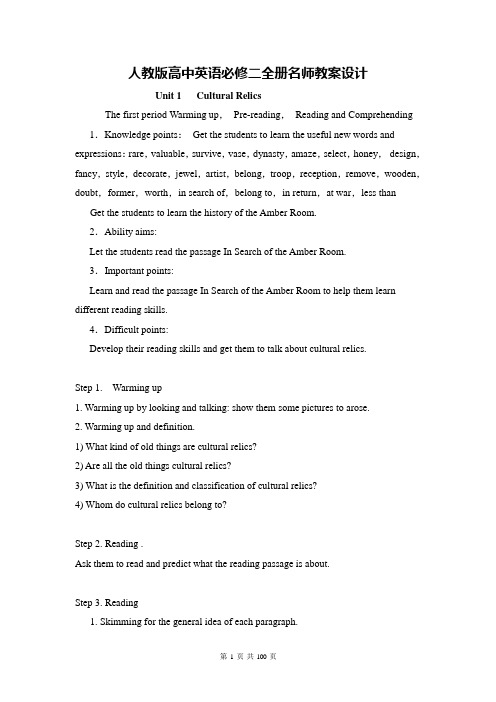
人教版高中英语必修二全册名师教案设计Unit 1 Cultural RelicsThe first period Warming up,Pre-reading,Reading and Comprehending 1.Knowledge points:Get the students to learn the useful new words and expressions:rare,valuable,survive,vase,dynasty,amaze,select,honey,design,fancy,style,decorate,jewel,artist,belong,troop,reception,remove,wooden,doubt,former,worth,in search of,belong to,in return,at war,less than Get the students to learn the history of the Amber Room.2.Ability aims:Let the students read the passage In Search of the Amber Room.3.Important points:Learn and read the passage In Search of the Amber Room to help them learn different reading skills.4.Difficult points:Develop their reading skills and get them to talk about cultural relics.Step 1. Warming up1. Warming up by looking and talking: show them some pictures to arose.2. Warming up and definition.1) What kind of old things are cultural relics?2) Are all the old things cultural relics?3) What is the definition and classification of cultural relics?4) Whom do cultural relics belong to?Step 2. Reading .Ask them to read and predict what the reading passage is about.Step 3. Reading1. Skimming for the general idea of each paragraph.2. Scanning for detailed information: read the text carefully and do exercises 1 and 2 in Comprehending.1). Join the correct parts of the sentences together.(1) Frederik I A. stole the Amber Room(2) Frederik William I B. sent a troop of his best soldiers to the King of Prussia(3) Peter the Great C. had the Amber Room made(4) Catherine II D. had it moved outside St Petersburg(5) The Nazi army E. gave it to the Czar as a gift(6) The Russians and Germans F. built a new one after studying pictures of the old one2). The following five questions summarize the main idea of the five paragraphs in the passage. Put the paragraph numbers in the boxes. Then answer the questions.□ How did the Amber Room become one of the wonders of the world?□ How was a new Amber Room built?□ How did the Amber Room get lost?□ How was the Amber Room made?□ Why did the King of Prussia give the Amber Room to the Czar of Russia as a gift?3. Deal with any language points students might meet.4. Reading aloud and underlining. (listen to the tape and pay attention to the pronunciation of each word and the pause within each sentence. Pick out all the useful expressions or collocations from the passage while reading and copy them to the notebooks after class.)5. Reading and transferring information. (Filling the table)6. 根据课文内容填空Step 4. Discussing the characteristics of the text:(This passage is a narrative prose or non-fiction article. It tells the history of Amber Room in the order of time so that we can clearly learn about what happened to it. The tense used the text is the past tense. )Step 5 Closing down by retelling the story of the Amber Room.Step 6 HomeworkLearn the useful new words and expressions in this unitTell the story of the Amber RoomThe second period: Learning about important language pointsImportant points: enable the students to grasp the usages of such new words and expressions as surviving, belong, doubt, belong to, in search of. Get the students to master the patterns: “sadly, although the Amber Room was considered one of the wonders of the world, it is now missing.” “There is no doubt that the boxes were then out on a train for Konigsberg”Difficult points: get the students to understand some difficult and long sentences.Emotional aims: Develop the students` spirits of cooperation and teamwork. Stimulate their interest in learning EnglishStep 1 Revision1) Check the homework.2) Retell the history of the Amber RoomStep 2 Reading and finding:Get the students read through Warming up, Pre-reading, Reading and Comprehending to underline the new words and useful expressions or collocations in these parts.Collocations: a cultural relics, be rare and valuable, survive for a long time, whether…. Or not, an amazing history, be used to do, the design of the room, the fancy style, popular in those days, give the name, decorated with gold and jewels, in fact, as a gift of, in return, be made to be a gift, serve as, add more details to, the search for, be mad for, one of the wonders, are objects, look much like…., at war, remove….from…, remain a mystery, be ready for….Step 3 Practice for useful words and expressionsDo the exercises in discovering useful words and expressionsStep 4 V ocabulary study(1) Survive:continue to live or exist,in spite of nearly being killed or destroyed Few survived after the flood.The custom still survives.The house survived the storm.He survived his wife for many years.(2) belong to:be the property of,be a member ofThe land belongs legally to the government.The blue sky belongs equally to us all.They belong to the younger generation.(3) in return: as payment or reward for sth.I bought him a drink in return for his help.(4) doubt: uncertainty or disbelief, reason for not believing sth.There is no doubt about it.I have doubts about his competence(能力).Please dismiss all doubts about it.It is human to doubt. 怀疑是人的天性.I doubt whether he is at home.(5) remain: be left or still present after other parts have been removed or used or dealt withAfter the fire, very little remained of my house.If you take 3from 8, 5 remains.Much remains to do.We should remain modest and prudent. (我们应该保持谦虚谨慎)Let things remain as they are. (保持原状吧.)Step 5 Sentence focus(1)This gift was the Amber Room, which was given this name because several tonsof amber were used to make it.The chairman, who spoke first, sat on my right.I`m seeing the manager tomorrow, when he will be back from New York.(2)The design of the room was in the fancy style popular in those days.(3)In 1770, the room was completed the way she wanted.I was never allowed to do things the way that I wanted.He was looking at her in the way that surprised her.We have to make it work in the way they want it to.(4)There is no doubt that the boxes were then put on a train for Konisberg, whichwas at that time a German city on the Balitic Sea.They had to face the fact that the nearest filling station is 30 miles away.The doctor came to the conclusion that the patient was suffering from cancer.I have no idea when he will return.There is no doubt that he is affine scholar.There is no doubt that you can find a way to solve this problem.Step 6 Using words and expressions (page 42)Step 7 Homework.Finish off the Workbook Exercises.Learn the useful new words and expressions by heart.The third period Learning about grammarKnowledge aims: enable the students to know the structure of the restrictive and non-restrictive attributive clausesImportant points: get the students to master the structure and usage of the restrictive and non-restrictive attributive clauses and the differences Difficult points: Enable the students to learn how to use the restrictive andnon-restrictive attributive clauses correctlyStep 1 RevisionCheck the homework exercisesDictate some useful words and expressionsStep 2 Warming up by reading and discoveringSome examples in the reading passage:This gift was the Amber Room, which was given this name because several tons of amber were used to make it.In 1770, the room was completed the way she wanted.This was a time when the two countries were at war.Later, Catherine Ⅱ had the Amber Room moved to the palace outside St Petersburg where she spent her summers.Step 3 Grammar learning(1)Looking and thinking:(2)Summing up and explanations.An adjective clause is a dependent clause which takes the place of an adjective in another or phrase. Like an adjective, used to modifies a noun or pronoun , answering questions like “which” or “what kind of”Relative pronouns: who / whom / which / thatRelative adverbs: when / where / why(3)Restrictive and non-restrictive attributive clausesMy uncle, who lives in London, is very rich.My uncle who lives in London is very rich.The policies, which were unpopular, were rejected by the voters.The policies that / which were unpopular were rejected by the voters.Step 4 Grammar practiceDo the exercises on page 4.Step 5 Closing down by a quiz1.Choose the right answers.(1) As many children ____ came were given some cakes.A. thatB. asC. whoD. whom(2) The visitors saw rows of houses the roofs _____ are red.A. on whichB. of whichC. whereD. that(3) I usually take a nap after lunch, _____ is my habit.A. which itB. as itC. asD. that(4) Please tell me the way ______ you did the job.A. howB. whereC. whichD. in which(5) Is this museum ______ some German friends visited the day before?A. the oneB. whichC. thatD. where6) The farmer uses wood to build a house ______ to store grain.A. in whichB. whereC. thatD. with which(7) I shall never forget the days ______ I spent in the country with the farmers,______ has a great effect on my life.A. when, whichB. that, whichC. when, thatD. which, that(8) Little has been done ______ is helpful to our work.A. thatB. whatC. whichD. all that(9) Perhaps this is the only market ______ you can get such cheap goods.A. thatB. of whichC. by whichD. where(10) We`ll put off the outing until next week, ______ we won`t be so busy.A. whenB. whichC. at whichD. in that(Answers: BBCDA ABADA)plete the sentences by combining the two ones. Use formal written English.(1) An antecedent is a word.A pronoun refers to this word.An antecedent is a word which / that a pronoun refers to.(2) The blue whale is considered the largest animal that has ever lived.It can grow to 100 feet and 150 tons.The blue whale which / that can grow to 100 feet and 150 tons is considered the largest animal that ever lived.(3) The plain was met by a crowd of 300.Some of them had been waiting for more than 4 hours.The plain was met by a crowd of 300, some of whom had been waiting for more than 4 hours.(4) In this paper, I will describe the basic process.Raw cotton becomes cotton thread by this process.In this paper, I will describe the basic process by which raw cotton becomescotton thread.(5) The researchers are doing case studies of people to determine the importance of heredity in health and longevity.These people`s families have a history of high blood pressure and heart disease.The researchers are doing case studies of people whose families have a high blood pressure and heart disease to determine the importance of heredity in health and longevity.(6) At the end of this month, scientists at the institute will conduct their AIDS research.The results of this research will be published within 6 months.At the end of this month, scientists at the institute will conduct their AIDS research, the results of which will be published within 6 months.(7) According to many education officials, “math phobia” is a widespread problem.A solution to this problem must be found.According to many education officials, “math phobia” is a wide spread problem to which a solution must be found.(8) The art museum hopes to hire a new administrator.Under this person`s direction it will be able to purchase significant pieces of art.The art museum hopes to hire a new administer under whose direction it will be able to purchase significant pieces of art.(9) The giant anteater licked up ants for its dinner.Its tongue is longer than 30 centimeters.The giant anteater, whose tongue is longer than 30 centimeters, licked up ants for its dinner.(10) The anteater`s tongue is sticky.It can go in and out of its mouth 160 times a minute.The anteater`s tongue, which can go in and out of its mouth 160 times a minute, is sticky.Step 6 Home workFinish off the workbook exercises.Preview the part Reading the passage on page 5, pick out the sentences with the non-restrictive attributive clauses。
The Amber Room 教案 - 副本
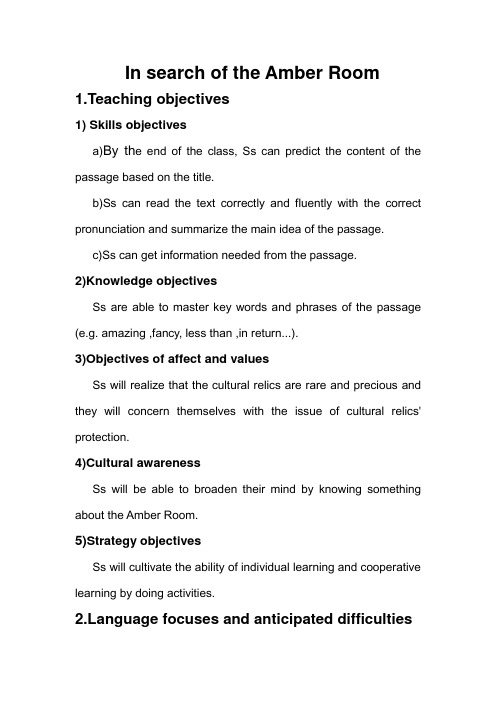
In search of the Amber Room1.Teaching objectives1) Skills objectivesa)By th e end of the class, Ss can predict the content of the passage based on the title.b)Ss can read the text correctly and fluently with the correct pronunciation and summarize the main idea of the passage.c)Ss can get information needed from the passage.2)Knowledge objectivesSs are able to master key words and phrases of the passage(e.g. amazing ,fancy, less than ,in return...).3)Objectives of affect and valuesSs will realize that the cultural relics are rare and precious and they will concern themselves with the issue of cultural relics' protection.4)Cultural awarenessSs will be able to broaden their mind by knowing something about the Amber Room.5)Strategy objectivesSs will cultivate the ability of individual learning and cooperative learning by doing activities.nguage focuses and anticipated difficulties1)Language focusesa)This is a reading period so the focuses are to cultivate the students' reading skill. The activities need to be designed to develop students' reading ability, such as predicting, scanning ,skimming and summarizing.b)It is also important for Ss to master the new words and phrases.2)Anticipated difficultiesa) Ss have a limited vocabulary, so they may have difficulties in understanding the passage. T will help them learn the new words and phrases.b)Ss may not hear the Amber Room before, so the teacher will tell them some background knowledge about it.3. Teaching methodThe-three model: Teaching reading in the classroom is divided into three stages in which the top-down and bottom-up techniques are integrated to develop the students' efficiency in reading and reading strategies. The three stages are pre-reading, while-reading, and post-reading.4.Teaching aidsUsing PPT documents to help Ss to understand the whole passage.5.Teaching proceduresStep 1 Lead-in (2mins)T gives a brief introduction to the Amber Room. Ss will know the Amber Room is a room which is made of amber and it is cultural relics in Russia.T:Today, we are going to learn cultural relics in Russia. It is a room made of amber . Do you know amber ?(T shows some pictures of amber and Ss get to know amber)[Purpose]In this step, Ss first know some information of the Amber Room. The background information will make it easier for Ss to understand the passage.Step 2 Pre-reading (2mins)T asks Ss to read the title of the passage and then ask them some questions. Ss will predict the content of the passage with the help of the title.T:Please look at the title "in search of the Amber Room", what does "in search of "mean?(If the Ss can't give the answer, then the T explains it. ) T:"In search of "means "looking for". Why are people looking for it? Can you guess? What will the passage talk about?(Ss predict the content, but T will not give the answer here.) [Purpose]T asks Ss to make prediction about the passage. The purpose is to help Ss to develop the reading skills of predicting.Step 3 While reading(24mins)Activity 1.Skimming (4mins)Ss skim the whole passage and find out the reason why people are looking for the Amber Room, check their prediction and summarize the main idea using their own words.Activity 2.Scanning(20mins)a)Please read the first three paragraphs and find out the functions of the Amber Room in different periods.b)Please read para.4 carefully and find out the reason why the Amber Room was lost?c)Please read para.5 carefully and catch as much information as possible. Later, T asks several Ss to answer questions one by one.[Purpose]By doing some activities, Ss will develop their reading strategies and language efficiency. T helps the Ss study the passage paragraph and paragraph. Ss will learn some key words and phrases in the passage.Step 4 Post-reading(11mins)Activity 1. Role play (5mins)T creates a situation in which a student is the tour guide ,she/he needs to introduce the Amber Room to the tourists. Ss can collect information from five aspects (material, style, decoration, length and color).Activity 2.Disscussion (6mins)Ss have learned the rebuilding of the Amber Room. T asks the Ss to discuss whether people should rebuild the cultural relics. T gives the example of "Yuan Ming Yuan" in Beijing which is also cultural relics. Ss share their opinions on the issue and the reason. [Purpose]These activities serve to be an output of the reading and an evaluation of their learning so as to develop the Ss' comprehensive language competence.7.Assignment (1min)a)Go over what they have learned today and try to recite the passage.b)Surf the net and find the information needed about cultural relics.[Purpose]By doing the homework, Ss can review the knowledge and learn more about cultural relics.。
高中英语_The Amber Room教学设计学情分析教材分析课后反思
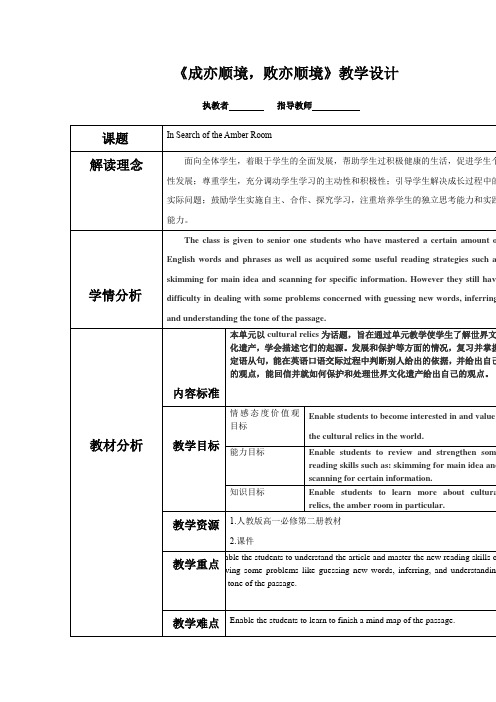
《成亦顺境,败亦顺境》教学设计执教者指导教师学情分析The class is given to senior one students who have mastered a certainamount of English words and phrases as well as acquired some useful reading strategies such as skimming for main idea and scanning for specific information. However they still have difficulty in dealing with some problems concerned with guessing new words, inferring, and understanding the tone of the passage.效果分析本课能密切联系学生的学习生活实际,精心选取典型的的事例,结合学生已有的生活经历和体验创设教学情境,设计符合学生实际的课堂活动,激发学生兴趣,调动学生学习的积极性;设计科学合理、有思维价值的问题,让学生在感悟、讨论、交流、辩论中深化自己的思想认识,形成正确的价值观念,同时培养学生自主合作、分析探究问题的能力。
教材分析本单元以cultural relics为话题,旨在通过单元教学使学生了解世界文化遗产,学会描述它们的起源。
发展和保护等方面的情况,复习并掌握定语从句,能在英语口语交际过程中判断别人给出的依据,并给出自己的观点,能回信并就如何保护和处理世界文化遗产给出自己的观点。
Reading是关于寻找丢失了的普鲁士国王威廉一世送给俄罗斯沙皇的那个琥珀屋的建立、被毁、重建的整个历史。
第一段说the amber room has “strange history”,并对它进行洋细的描述。
第二段叙述了the amber room的来历及其在俄国的用途:沙皇的冬宫和会见重要客人的会客室。
高中英语必修二Unit 2 In search of the Amber Room 英语说课文档
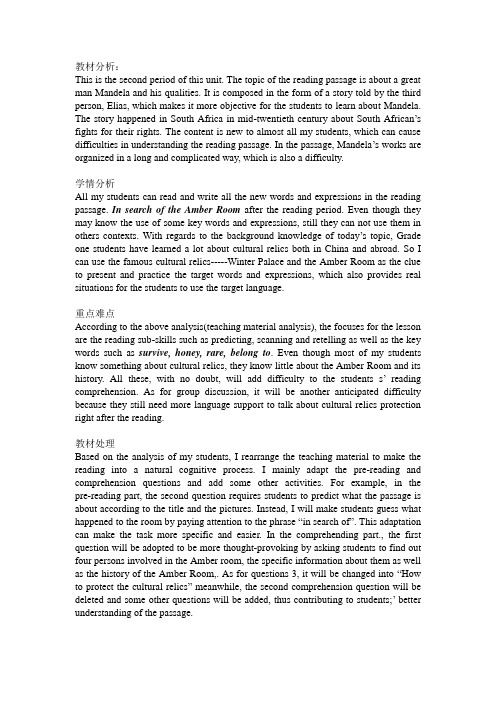
教材分析:This is the second period of this unit. The topic of the reading passage is about a great man Mandela and his qualities. It is composed in the form of a story told by the third person, Elias, which makes it more objective for the students to learn about Mandela. The story happened in South Africa in mid-twentieth century about South African’s fights for their rights. The content is new to almost all my students, which can cause difficulties in understanding the reading passage. In the passage, Mandela’s works are organized in a long and complicated way, which is also a difficulty.学情分析All my students can read and write all the new words and expressions in the reading passage. In search of the Amber Room after the reading period. Even though they may know the use of some key words and expressions, still they can not use them in others contexts. With regards to the background knowledge of today’s topic, Grade one students have learned a lot about cultural relics both in China and abroad. So I can use the famous cultural relics-----Winter Palace and the Amber Room as the clue to present and practice the target words and expressions, which also provides real situations for the students to use the target language.重点难点According to the above analysis(teaching material analysis), the focuses for the lesson are the reading sub-skills such as predicting, scanning and retelling as well as the key words such as survive, honey, rare, belong to. Even though most of my students know something about cultural relics, they know little about the Amber Room and its history. All these, with no doubt, will add difficulty to the students s’reading comprehension. As for group discussion, it will be another anticipated difficulty because they still need more language support to talk about cultural relics protection right after the reading.教材处理Based on the analysis of my students, I rearrange the teaching material to make the reading into a natural cognitive process. I mainly adapt the pre-reading and comprehension questions and add some other activities. For example, in the pre-reading part, the second question requires students to predict what the passage is about according to the title and the pictures. Instead, I will make students guess what happened to the room by paying attention to the phrase “in search of”. This adaptation can make the task more specific and easier. In the comprehending part., the first question will be adopted to be more thought-provoking by asking students to find out four persons involved in the Amber room, the specific information about them as well as the history of the Amber Room,. As for questions 3, it will be changed into “How to protect the cultural relics” meanwhile, the second comprehension question will be deleted and some other questions will be added, thus contributing to students;’ better understanding of the passage.教学目标The shinning points of the lesson involve not only the design of the learning activities but also the way to achieve the learning objectives.As for the language skills, the students have predicted the content according to the title and its key words. They have found out some specific information of the people who are involved in the change of the Amber Room by scanning.Secondly, knowledge objectives. The students not only have known the meanings of some new words, phrases and the structure (have…done) but also could use them when retelling the story.Thirdly, cultural awareness, the students have realized the value of cultural relics and developed a strong desire to protect them after the group discussion.教学方法Reading is an interactive process which involves not only the printed page but also the reader’s previous knowledge of the language in general, of the world and of the text types. Therefore, I will follow the interactive principle and adopt the three-stage-model in this reading period. The three stages are pre-reading, while-reading and post-reading.教学媒体In order to conduct the lesson effectively, I’ll use multimedia devices as well as the traditional teaching aids, such as pictures, red objects and so on. Some real objects from students are put in a prepared bag. They are used in the activity “Finding the owner”. A tape recorder will be used in listening activity, and other multimedia devices are used to create lifelike situations to present the meaning and the use of the new words and expressions for the students to understand and practice the language better.布置作业At the end of the class, I will present homework. The first piece is a must for everyone. The students are required to write a short passage in 80-100 words to describe the appearance or to introduce the history of the Amber Room. And then they are required to give the description or introduction before class the next day as a checking of their reading comprehension and the using of the newly learned words and expressions. The second piece is optional. It can be done at home during the weekend. They will give at least three pieces of advice and see my comments later. The optional homework is for those who want to learn more and can do more in my class. This is an effective way to arouse the students’ interest in using the language, and it will meet different students’ learning needs.板书Finally,the blackboard notes. On the left are all the key words the students should master in this lesson as well as past tense forms of verbs. In the middle, the useful sentence structures are presented, which can help students learn and use them incommunicative classroom activities.教学过程These are my teaching procedures. Now let’s take a look step by step.Before class, I will play Kurt Nilsen’s song Day off. This song is designed to attract students’ attention and get them ready for class.The first step is warming up. I will ask the students to guess what Kurt did on his day off by brainstorming. It can activate students’background knowledge and help them review the past tense forms of some verbs, which are helpful for students’writing. Then, I’ll provide the students’ with some pictures. I will ask the students to talk about the activities Kurt did on his day off. In this activity, some new words will be learned such as yard sale. And the students will get a brief idea about the sequence of time.At the end of warming-up activity, I will ask the students “Kurt really had a good day off. How about Nick?” Then a picture will be shown. The students will talk about this picture, focusing on the place, the activity, and the weather. In this activity, they will learn some new words in the reading passage such as yard sale, umbrella, raincoat, get wet, in my opinion, etc. It aims to predict the content of the reading passage. Here, one phrase is quite new to the students. That is “yard sale”. So I will provide the students some background information. This is very important for them to learn the meaning and the function of “yard sale”. After this pre-reading activity, the students will feel totally ready for the reading, so next step is while reading. For while-reading, I will ask the students to read this passage and take notes of the activities Nick did on his day off. Thus, the students will read for the specific information to get some input. They will use the useful expressions in their writing later. After checking the answers, the students will be asked to show their opinion about Nick’s day off.Next step is post-reading. I will help the students understand the writing structure.I will ask them what activities Nick did, when Nick did the activities, why he did the activities and what happened. In this way, the students will find out the model structure which will help them understand how to write one’s day off clearly in the sequence of time. Then, I’ll ask the students to retell Nick’s day off according to the structure. By retelling, the students will understand the passage better. They will not only have a better understanding of the reading content, but can also summarize the structure for talking about somebody else’s day off with the help of the teacher. This is the structure students will know. That consists of three parts: beginning, body and ending. If the students just know the structure for writing, it is not enough for a good writing. Many useful expressions should be used in their writing as well. So next, I will ask the students to read this passage and find out the nicely used expressions. When we finish, we will learn the words and expressions together. I will provide the students an opportunity to use the newly learned structure and vocabulary. So in the next step --- writing preparation. I will create another situation. That is Tom’s day off. The students will talk about Tom’s day off by using the structure and the vocabulary they’ve just learned. Then three passages (Passage A, B, C) will be provided. Thestudents will be asked to find out the better one ( Passage A vs. B) and tell the reasons. Passage B is better, because there are two mistakes in Passage A. but there are no mistakes in Passage B. And Passage B is clearly written in the sequence of time. Then Passage C will be presented (Passage B vs. C). The students are also asked to find out a better one and tell me the reasons. Passage C is better because Passage C is not only well written in the sequence of time but many nice expressions are used. So now students will know a good passage must have a clear structure, correct grammar and good expressions. In this activity, I will not tell the students what the writing strategy is. In fact, they will be led to find it out by comparison.Now, based on the preparations above, the students will get ready to write. So, next step is writing. I will ask the students to write the passage about their day offs. It will take them about 5 minutes. This activity is used as a practice on using the structure, the useful words and expressions and the writing strategy they’ve just learned.After they have finished their writing, I will ask the students to exchange their writings with their deskmates. Firstly, they will correct their works according to the requirement. In this activity, the students will learn cooperatively. Next, we will share one or two students’ writings with the help of the OHP. By doing this, the students will know how to revise their classmates’ works according to my example. Thus we can check how well the students can do the job.。
高中英语人教版(2019)必修第二册 Unit 2 教学设计(表格式)

B2 Unit 2 Listening & talking & Project
教学课时
共1课时
教学目标(目标要立足核心素养且清晰具体,可操作、可执行、可评价)
1.通过听力和阅读语篇,积累表达目的以及人类帮助动物活动的短语,提升语言能力。
2.通过在真实情境中拟定援救计划,应用所学,解决问题,提升思维品质和学习能力。
Assignment:
英语学习活动观:II&III
设计说明:通过落实到笔头,并以小组作业的形式,展示小组活动的结果。
备课反思
本节课设计了听力、阅读和小组活动等活动,活动主题是小动物救助。学生通过观看图片,听力训练,阅读文本,了解并熟悉鸟类观察所需的设备,鸟类俱乐部的活动以及小动物救助站的活动,最后根据真实情境,利用所学,帮助受伤的小鸟以及寒冬里无处觅食的小猫解决问题。学生通过这些活动,一方面掌握目的的表达以及人类活动的表达,同时也提升了保护野生动物的意识。
Q2: Who started it?
Q3:What animals were rescued?
Q4: What help does the center need?
Activity 6: Read and find out what people do to help the animals in the shelter.
3.通过小组活动,形成帮助野生动物的意识,并在生活中关爱小动物。
学习形式
课前:图片配对及完成句子,了解并熟悉观察鸟类的设备的英语表达;
课中:听力回答问题以及填空和阅读回答问题以及找出动词,整理目的表达的短语和人类帮助动物活动的短语;
课后:制订援助计划,帮助受伤的小鸟以及寒冬里无处觅食的小猫解决问题
高中英语_In search of the amber room教学设计学情分析教材分析课后反思

教学设计普通高中课程标准试验教科书英语2 (必修)Unit 1 Cultural relics课型:Reading授课时间:45分钟/节总体目标:培养学生良好的学习习惯,通过识别、理解、推理、概括、重构、阐述六个层面提升语言运用能力, 结合高考的特点,把各种高考题型贯穿到单元教学中,逐步提高学生运用语言的能力。
教学配合资源:学科网、英语教师网教学设计与实施:高一英语备课组BookⅡUnit1 Cultural relics设计教师:教学年级:高中一年级教材版本:普通高中课程标准试验教科书(必修2)人民教育出版社出版一、学生分析:学生分析本单元的设计与实施是建立在学生经过半个学期的高中学习生活,学习完必修一知识的基础之上,学生已经初步适应了在活动与任务中学习英语以及如何处理语言知识与活动开展的关系,他们也逐步形成并培养了一定的小组合作学习及自主学习的能力。
对于高一上学期的高中学生来讲,该话题比较陌生,但比较吸引人。
学生尽管对这篇文章的理解有一定难度,如琥珀屋如何成为稀世珍宝,它在二战中的神秘失踪等,但通过教师对于文章篇章结构的理解和失踪的来龙去脉的解读,学生不但能主动探究,并且对于文化遗产有更进一步的了解。
二、教材分析:本单元以cultural relics为话题,旨在通过单元教学使学生了解世界文化遗产,学会描述它们的起源、发展和保护等方面的情况,复习并掌握定语从句,能在英语口语交际过程中判断别人给出的依据,并给出自己的观点,能回信并就如何保护和处理世界文化遗产给出自己的观点。
1.Warming up部分首先让学生对文物的定义有所了解,然后让学生讨论文物所应具有的特点,在此基础上让学生看几幅图片,进一步讨论“是不是只有像花瓶这样的东西才算是文物,建筑物算不算文物”这个问题。
2.Pre-reading部分是Reading的热身部分,设计了两个问题让学生对琥珀进行初步的了解。
第一个问题是你见过琥珀吗?对它了解多少?第二个问题是让学生通过课文标题和图片预测文章的主要内容。
- 1、下载文档前请自行甄别文档内容的完整性,平台不提供额外的编辑、内容补充、找答案等附加服务。
- 2、"仅部分预览"的文档,不可在线预览部分如存在完整性等问题,可反馈申请退款(可完整预览的文档不适用该条件!)。
- 3、如文档侵犯您的权益,请联系客服反馈,我们会尽快为您处理(人工客服工作时间:9:00-18:30)。
高中英语教学
Amber Room
潍坊实验中学
高一二部英语组肖电芬
Amber Room
一、学生分析
教学对象为高中一年级学生,智力发展趋于成熟。
他们的认知能力比初中阶段有了进一步的发展,渐渐形成用英语获取信息、处理信息、分析问题和解决问题的能力,因此我特别注重提高学生用英语进行思维和表达的能力。
他们学习英语方法由死记硬背转型向理解型并应用到交际上,他们有自己的学习技能和策略,学会把语言学习与现实生活和兴趣联系起来。
通过任务型课堂活动和学习,学生的学习自主性得到加强,不再认为英语的课堂学习很枯燥,主动参与到活动中去,成为课堂的主体,同时也加强了与他人交流合作的能力。
学生已经完成了高中英语第一个模块的学习,渐渐习惯了我的教法。
虽然一开始他们觉得与初中教学很不相同(初中老师注重手把手式的语法教学),但经过半个学期后,他们适应得很快,而且还取得一定的进步。
他们会对课文内容提出自己的疑惑和勇于阐述见解,并且从课内知识拓展到课外,通过多种渠道获取学习资源。
不过,本班学生的水平参差不齐,有些差距还相当大。
因此在教学过程中,布置的任务要兼顾各个层次的学生,使他们都有所收获。
二、教材分析
这一课是本单元第一个课时。
在上这一节课前并没有让他们了解太多的与课文内容相关的知识,只是由于这课出现的人名和地方名比较多,我在课前教他们读了一下。
我在备这一课时,发现它的 warming-up部分会花费比较长的时间,于是我没有采用,而使用了我自己另外准备的引入(只是花了4到5分钟的时间),让学生对这课的话题作好心理准备,也为了完成本单元的目标作了铺垫。
我觉得在今后也必须合理使用手中的教材,根据学生水平和教学设计进行整合或增减,让不同层次的学生在课堂上都有所收获。
三、教学目标
本课为阅读课型,主要介绍有关俄罗斯遗失琥珀屋的轶事。
通过阅读使学生了解世界文化遗产,学会描述他们的起源、发展和保护等方面的情况。
教师根据课文内容用不同的形式来让学生自己归纳,提高阅读技能。
由于这课讲述国外文化遗产,学生会感到陌生,为了引起共鸣,因此要把中外文化遗产结合一起讨论。
本课目的要使学生学会如何谈论文化遗产以及最后形成保护文物的意识。
教学内容大致分为以下几个方面:
1.看图片和听录音引入文化遗产这一话题。
2.从网上下载一些琥珀屋图片并展示给学生看,分辨新旧琥珀屋,给学生以感官上的刺激,而且有利于帮助学生对文章的理解。
(一些生词用板书)
3.学生阅读课文后完成精读练习。
4.两人围绕琥珀屋设计小对话。
5.语言学习--难句解释。
6.小结文章,一是找关键线索,二是写作手法。
7.小组讨论,包括复述课文,加深对文章的理解,以及学生总结自己通过
本课学习学到了什么(达到教学目标--形成保护文物意识)。
四、教学策略
环环相扣,设计紧凑。
先利用录音和图片引起兴趣,然后带着问题有目的地阅读文章,通过回答问题掌握细节,知道琥珀屋从形式-失踪-重建的过程,再
从整体上把握它的结构、特色,学习用英语归纳以及复述,最后自己去小结上完这节课的收获,使他们的掌握阅读技巧的同时也增加了见识。
在小组讨论过程中,学会用英语口语判断别人给出的依据,并给出自己的观点。
采用多媒体教学,用一些有关文物的精美图片,引起学生对即将阅读的文章的兴趣,减少陌生感。
课前需要准备中外文物图片以及对这些图片简短的录音描述。
五、教学过程
(一)warming-up引入
教师用 PowerPoint分别展示三幅图片以及播放有关的三段介绍录音,并不需要学生详细记录细节,因为不是听力课,只是了解图片是什么地方,位于哪个国家等。
( look at three pictures and listen to three tourist guide describe each of them. What do you think of them?)
1、3为学生所熟悉的
1. The Pyramids in Egypt
2. Machu Picchu in Peru
3. The Great Wall of China
然后问问题:
what do you think of them?
(They represent the culture of their countries, so they are called______) 引导学生讲出 cultural relics这个词组
接着分别说出 cultural relics的定义(学生个人观点)
(引入部分使学生对本节课的话题有所了解,而且很有兴趣了解其它文物)(二) Reading使学生了解Amber Room形成、发展,经历了几个阶段
1、让学生解释文章的title—In Search of the Amber Room (Maybe it's lost)
2、为了让学生知道琥珀屋是什么样子,帮助理解文章,教师展示多张图片,新旧琥珀屋对照、外观、以及里面摆设的琥珀,金碧辉煌的琥珀屋使学生大开眼界,叹为观止,并学会分辨新旧。
3、先给出一系列问题,让学生带着问题阅读课文(scanning)。
有目的性阅读是阅读训练一种技巧,并且提醒学生不用太多花大多注意力在人名、地名上面,而假设自己正在读一本侦探小说,集中精力探究事情的发生经过。
4、阅读后学生回答问题(大部分学生能找到答案)
5、在了解细节的基础上,再次阅读(skimming)。
全班分5个小组,分配任务给每一个组,文章共有5段,每组概括一个段落的大意,而且要求使用不超过
3个单词来概括,既降低了难度又提高了学生归纳能力。
(三) Difficult points
因为只是阅读课,语言点不作详解,是为下个课时作准备,分别找出 4句
难句,让学生进行解释,一一说明属于什么从句(分别有宾从、状从、定从、主从)(从句是学生的薄弱环节),为学生扫除阅读障碍。
l. Frederic WilliamⅠ,the king of Prussia could never have imagined that his greatest gift to Russian people would have such a strange history.
2. Once it is heated, the amber can be made into any shape.
3. This was a time when the two countries were at war.
4. There is not doubt that the boxes were then put on a train for Konigsberg .
(四)Summing-up(总结)
学生掌握每段大意后,从总体上把握文章结构和特点
1、找出与Amber Room有关的重要线索(3个人物、2个国家、1个组织)
2、分析写作手法(时间顺序及都用了一般过去时描述已发生的事情):让学生将来进行写作训练描述某事经过时,可以模仿这篇文章的手法(五) Group-work(task)4人小组
学生此时已非常熟悉文章内容及结构,进入用英语进行交际环节
1、复述课文,教师给出一段文字,中间有不少空格,学生根据课文内容填写空格(learn how to talk about cultural relics)
Fill in the blanks:
The Amber Room was made________. Frederick WilliamⅠ________.It soon became part of the Czar's winter palace in St. Petersburg . Later, CatherineⅡ________and she told her artists to________. In September, 1941,the Nazi Germany army secretly ________. After that, what happened to the Amber Room________. Now Russians and Germans have ________much like the old one.
2、谈谈自己从中的收获(What can you learn from the text?)
学生都能说出要保护文物(完成本课教学目标)至于怎样保护,因时间关系留待下个课时再讨论。
(六)布置作业:复习课文及写一篇如何保护家乡某一文物的文章。
